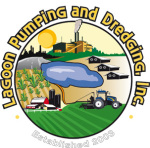
Lagoon, Lake and Pond Dredging
If an active pond, lake or lagoon is not practical to effectively agitate or suspend the silt, sand or solids, then dredging is the answer. Due to the amount of equipment and complexity of dredging, this is a more expensive option.
Dredging is the method used for small lakes, ponds and lagoons in the following situations:
• Shallow ponds or lagoons such as municipal lagoons where make-up or return water is available
• Dense sludge or sediment on lake, pond or lagoon bottoms
* Lagoons, ponds or lakes with bottoms of sand or heavy sediment that drops out of solution quickly
• Very large lagoons where agitation alone will not suspend solids long enough for pumping
The process includes a dredging barge with a tiller on a long arm that is lowered to the lagoon or lake floor that loosens the substrate enough for a low pressure high volume centrifigal pump to vacuum up and discharge the water silt, sand sludge mix through a 8" firehose hose that is floated to closest shore line. Then a high pressure centrifigal pump increases the pressure and volume of effluent so it can be pumped to a spot to deposit or store the sewdiment tailings. This site can be close or even several miles away.
With dredging a barge with a cutter head is put into the lagoon and it traverses the pond or lagoon on a cable that follows a swath or path every 8 feet apart. This dredge is then moved systematically across the lagoon in swaths or lanes eating or cutting through a 24" layer of silt, sludge or sediment per pass. This is mixed with water and pumped into the fields through the same hose and drag line injection system as with pumping. It takes approximately 1000 gallons of water to move one cubic yard of sediment or sludge. Multiple passes are often required on the same swath to reach the desired depth.
Approximately 1 to 2 cubic yards of silt or sludge is removed every minute of dredging. This is dependent on how hard packed the silt or sludge is. The dredge is driven into sludge as fast as the tiller tines can break up the sludge and the centrifugal pump can suck up the loosened silt laden water. The drege pumps at 2000 gallons per minute. Ususal forward speed is 2 to 3 feet per minute. Due to unproductive back-ups and uneven silt bottoms the dredge tiller head is only engaged into the sludge about 60% of the time.
Dredging needs a minimum of 3 feet of water above the lake, pond or lagoon floor in order for the dredge to float. This requires make-up water or return water to the pond, lake or lagoon being dredged. This make-up water is often the same water that is used to deliver the sludge or sediment to the final location. In such cases settling basin is constucted to slow down the water sufficiently to allow the sludge or sand to drop out of solution. Then a return pump, sluice or drain line is set up to return the water back to its source. When dredging sanitary waste-water lagoons, waster-water sludge or animal manure slurry it is directly applied to agriculture farm land, then the make-up water needs to come from a well, another lagoon or another ready source of silt free water.
Pumping to a settling basin is a large containment area big enough to allow the water to slow down for the sediment and silt to drop out of suspension. It takes only minutes for sand and gravel to drop out of suspension. It will take 1 to 3 days for silt to drop out suspension; and if it is small clay particles or colloids it may never drop out of suspension without the aid of a polymer flocculant. The settling basin should be large enough for 3 days of inflow before the water will exit back into the main bodh of water.
Another method of capturing and dewatering the silt is to pump the effluent through a geo-textile dewatering bag. This requires the use of polymer flocculants to clarify the water; the geobags are used to contain the silt and sediment as the product is being dewatered.
Using geo-textile bags and polymers can add another $.008 cost per gallon of effluent or about $8.00 per cubic yard of sediment. Once the silt and sediment is dewatered these bags can be cut open and the silt hauled away; or the bags can be cut open and the silt spread around as top soil with a grass or vegetation cover grown on top of it. Sand and couse sediment can be dewatered in several days; but it may take months before the silt is dewatered sufficiently for it to be stable enough for repurposing the product.
Lagoon Pumping & Dredging, Inc.
For information, quotes and sales: Call the representative for your area:
North East: NE, SD, IA, N-MO, NE-KS: (402) 270-1366 (Brian Jakub)
South West: W-TX, NM, W-OK, CO, WY, MT, W-KS: (763) 355-4099 (Steve Larson)
South East: E-TX, E-OK, S-MO, SE-KS, LA, MS, AR (405) 406-7979 (Jason Lee)
Main Office: (402) 563-3464 (Accounting, Emergencies, Management)

